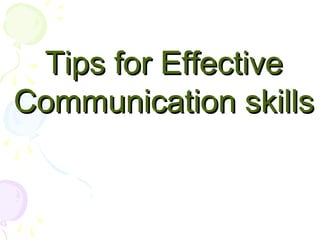
10 tips for effective communication skills
- 1. Tips for EffectiveTips for Effective Communication skillsCommunication skills
- 2. Introduction • What is the importance of information? • What is the effect of incomplete Information?
- 3. Which are Important points to improve communication skills? 1. Communication skills = 10% words + 30% (tone +tuning) + 60% body langyage. • What is tone? • What is tuning? • What is body language ? • What is miss communication?
- 4. Which are Important points to improve communication skills? 1. Confidence 2. Enthusiasm (Zeal) 3. Clear objective / Aim 4. Self prepared script 5. Subject matter 6. Effective start 7. Clear voice
- 5. Which are Important points to improve communication skills? 08. Speed 09. Logical presentation 10. Audience 11. Local language 12. Effective end 13. Time limit 14. Prayer
- 7. (1) Effective Speaking (A) DAILY SPEAKING: • Remember the person to whom you are talking • Don’t put hands in your pocket while talking to senior in a non-casual manner • Don’t chew anything when you talk • Avoid playing with a pen or any object • Look at the person, not away from him • Do take off your sunglasses • Remain as NORMAL as you can
- 8. • Presentation • Visual aids • Delivery (B) Public Speaking :
- 9. • Always try to understand the audience. • Keep in mind the number of people male-female mix • Determine the general attitude of the audience to the topic. • Analyze the mood of the audience [a] Good Presentation :
- 10. • Determine the audience understanding of the subject. • Preview the main points • Limit the speech to three or four main points. • In a large presentation include previews and summary of major points.
- 11. • Use visual aids to show how things look, work and relate to one another. • Use visual Aids to highlight information and create interest. • Select appropriate visual Aids • Limit visual as per main point • Make sure equipments works [b] Visual Aids :
- 12. • Establish eye contact • Speak clearly • Do not go to fast • Be sure every one hear • Speak in your natural style. • Stand up straight • Use gesture in natural appropriate way • Encourage question • Respond to question without being side track [c] Delivery :
- 13. • Fear of writing • Visualize your audience • Create a productive environment • Make an outline or notes • Just start • Write the middle first • Give orders • Say thing directly • Adopt a tone of confidence about what you say (2) Effective Writing
- 14. • Look beyond the speaker style by asking yourself what the speakers knows that you do not. • Hold your rebuttal until you have heard the total message • Listen for the central theme • Keep an open Mind (3) Effective Listening
- 15. • Fight distraction by closing doors, turning off radios and T.V. • Make meaningful notes that are brief and to the point. • Stay ahead of the speaker by anticipating what will be said next. • Evaluate and criticize the content not the speakers.
- 16. • Remove all distractions like T.V. Radio etc. • Ensure proper lighting • Don’t make the surrounding too comfortable • Read twice for better understanding • When you don’t have the meaning of any word, use the dictionary, do not make assumptions. (4) Effective Reading
- 17. • Gestures: Posture • Vocal qualities • Attitudes • Facial expression • Eye behaviour (5) Non-verbal Communication